Mark Sisson's Blog, page 304
April 7, 2014
Dear Mark: Liver for Babies, Flax Seed, and MCTs with Fruit
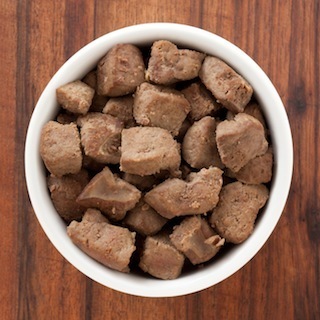 For today’s Dear Mark, I’ve got a three-parter. First I discuss the suitability and proper dosage of grass fed beef liver for babies and toddlers. It’s definitely a good choice, but you do have to keep a few parameters in mind to do it right and do it safely. Next, I discuss flax seed. Is it a good choice? Does it have health benefits beyond the meager conversion of alpha-linolenic acid into longer-chain omega-3s? Finally, I explore what happens when you eat medium chain triglycerides – the fats most prevalent in coconut oil – with fruit or other carb sources. Good, neutral, or certain death?
For today’s Dear Mark, I’ve got a three-parter. First I discuss the suitability and proper dosage of grass fed beef liver for babies and toddlers. It’s definitely a good choice, but you do have to keep a few parameters in mind to do it right and do it safely. Next, I discuss flax seed. Is it a good choice? Does it have health benefits beyond the meager conversion of alpha-linolenic acid into longer-chain omega-3s? Finally, I explore what happens when you eat medium chain triglycerides – the fats most prevalent in coconut oil – with fruit or other carb sources. Good, neutral, or certain death?
Let’s go:
Hi Mark!
How much cow liver is safe for a 14-month-old? We cooked up some high quality, grass-fed liver from a local farm here in NY, and our daughter LOVES it. Should we be worried about vitamin A or iron, or limit her intake?
Thanks,
Katie
First of all, great job! If your 14 month old is digging liver this early, you’ve probably got a very adventurous, non-fussy eater on your hands. Cultivate and encourage this attribute.
Second, while the recommended upper limit for kids aged 1-3 is 2000 IU of preformed vitamin A (retinol, the type in animal products) per day, you probably don’t need to worry too much. That’s a little less than a half ounce of beef liver. How much is she eating, and is it every day?
You can probably go higher than that, too, since true vitamin A toxicity requires really high intakes, vitamin D increases the upper limit and reduces the toxicity of vitamin A, and supplemental vitamin A seems to be more problematic than food-based vitamin A (at least in regards to causing birth defects during pregnancy). If your kid is getting sun, taking vitamin D, or eating a good amount of vitamin D-rich foods like sockeye salmon or sunbathing mushrooms, she’ll be able to tolerate higher levels of vitamin A and more beef liver. Heck, she won’t just tolerate higher levels, she’ll actually require more vitamin A to balance out the vitamin D.
I wouldn’t worry about the iron content. Babies and toddlers actually need more iron than older kids due to their rapid growth. If anything, most parents and pediatricians fret about their kids getting sufficient levels of iron in their diets. Plus, the iron in liver is way more absorbable (and less constipating) than supplemental iron, so it’s the preferred form.
I’d stick to about a half ounce to an ounce per feeding if you’re feeding regularly. Don’t give beef liver every day, and make sure she’s getting vitamin D somehow.
You could also try mixing in pastured chicken livers, which are higher in iron and folate but much lower (while still being “high enough”) in vitamin A than beef liver. They’re also much milder, for all you parents with pickier, more squeamish kids.
Just keep the polar bear liver away from your daughter and I think you’ll do just fine.
Hi Mark,
The university of Manitoba recently published a finding on a study of long term flax consumption that concluded earlier this year.
It’s a pretty interesting read as I know you’ve written articles about flax consumption on the site before.
Lucas
I agree – that is an interesting bit of research. Flax seed does appear to lower blood pressure in people with hypertension. Let’s take a look at some other recent evidence to see how flax stacks up.
In 2013, researchers compared the metabolic and lipid profile effects of flax seed oil to those of olive oil in healthy, young adults who were habitual olive oil users (not abusers, mind you). They found no significant differences in biomarkers, except for greater levels of of alpha-linolenic acid (ALA) in the flax group and lower c-reactive protein (CRP, a marker of inflammation; lower is better) in the olive oil group.
Flax seed was able to lower cardiovascular disease markers in a recent RCT, but it was in comparison to wheat. Doesn’t take a whole lot to beat wheat. Another study comparing flax seed to “wheat germ placebo” (hell of a placebo!) had merely a “limited effect on apolipoprotein metabolism.”
Flax may also modestly lower testosterone, which is good when you have prostate cancer, but probably bad if you’re an otherwise healthy male. However, high levels of ALA in the blood are a risk factor for the occurrence of prostate cancer, as I’ve written previously, so we may be dealing with a “good if you have it, bad if you don’t” type thing.
So, it’s not bad. Better than wheat (big deal), but the primary benefits seem to revolve around the effect on hypertension. Other effects are modest. And most evidence suggests that, in humans, conversion of the plant omega-3 ALA into EPA and DHA (which have the most beneficial effects in us) doesn’t happen very efficiently; women are better at it than men, especially if they’re pregnant.
If you’re going to use flax, milled flax seed seems to be the ideal form. The oil is way too unstable, the whole seeds are nigh impossible to digest, while the milled flax seed protects the oil, contains prebiotic fiber, and can be fully digested. The initial study you sent found that milled flax was the most beneficial form. You can buy your seed pre-milled or mill the whole seed yourself.
Hi Mark,
Fully entrenched in the primal food lifestyle both personally and professionally I have a question regarding coconut and carbs. Given the preferential burning of MCT in coconut as energy, what happens metabolically when you combine coconut via cream, milk flakes or oil with carbohydrate? Will even less carbohydrate be used for energy as you tick along in the day and therefore cause greater conversion to triglyceride or will glucose still win out in the race for conversion to energy? We keep our carb load low but as a larger number of recipe ideas creep out combining coconut and whole fruits, dried fruits and honey I am interested in the level of fall out from this combination.
Thank you for providing a resource that has answered countless questions for me already via your search function.
Cheers
Leeann
I suspect coconut oil/MCTs pair quite nicely with moderate amounts of carbs/fruit for several reasons:
1. The traditional diets of Pacific Island people tend to be fairly high in both coconut fat and carbohydrates (whether through sweet potatoes or fruit) and they manage to maintain good health. Famously, the Kitavans eat by all accounts a high-carb diet and obtain most of their saturated fat through coconuts. 69% of their calories come from carbs (mostly starches with some fruits) and 21% come from fat (mostly coconut with some fish).
On the other side, you’ve got the Tokelau obtaining 63% of their calories from coconut (yes, all their calories), 13% from starchy taro or breadfruit, and 3% from sucrose while showing almost zero evidence of cardiovascular disease or obesity. Moreover, the way they consume their coconut is to cook the starches in coconut cream. So these guys aren’t doing cyclical ketogenic diets or anything where their coconut oil is separated from their carbs; they’re eating their moderate amounts of starches immersed in a bath of MCT-rich coconut fat.
These accounts don’t prove anything, but they do suggest it’s possible for coconut and carbs to coexist amicably.
2. There’s some evidence that consuming medium chain triglycerides with your carbohydrates can reduce the blood glucose response and improve body fat metabolism. In one study (PDF), MCTs reduced post prandial blood glucose levels compared to other types of fats when eaten with carbs. Another study found that the addition of two tablespoons of coconut oil per day to a “balanced, hypocaloric diet” reduced abdominal fat in overweight women. Seeing as how “balanced” invariably means “moderate-to-high-carb” and the control group had identical dietary instructions except to use soybean oil instead of coconut oil, the latter seems safe enough.
3. Typical ketogenic diets prescribe extremely low levels of carbohydrate in order to induce ketosis. That’s how the clinicians treating epilepsy do it, and it’s how most regular folks attempting to reach ketosis do it. It’s also how fasting causes ketosis. However, you can also induce ketone production by consuming medium chain triglycerides or coconut fat on top of your regular diet. And, according to a series of animal and human studies, the benefits of ketones persist even with carbs in the diet:
In Alzheimer’s patients, drinking an MCT smoothie increased ketone levels and improved cognition. Most importantly, the amount of ketones generated correlated with greater improvements. The rest of the diet was unchanged.
In rodents with Parkinson’s disease, ketone infusions mitigated negative symptoms of the disease. In other words, the presence of ketone bodies in the circulation – similar to adding MCTs to your existing diet – was enough to get the beneficial effects.
What’s all this mean? I think you should go ahead and try out the combination. If it doesn’t work, you’ll know it because you’ll gain weight and suffer other negative symptoms. If it does work, you’re in luck because coconut milk poured over frozen berries is an amazingly delicious treat.
That’s it for today, guys. Thanks for reading, and keep the questions coming!
Get the 7-Day Course on the Primal Blueprint Fundamentals for Lifelong Health Delivered to Your Inbox for FREE




April 6, 2014
Weekend Link Love
 Next week, I’m speaking at Paleo f(x), along with other paleo/Primal luminaries like Robb Wolf, Chris Kresser, the Hartwigs, Nora Gedgaudas, and dozens more. I’ve got three talks scheduled – two on the 11th and one on the 12th – and you can buy separate tickets to each day, or a full three-day pass. If you can’t make the event, you can stream it, live, on your computer or mobile device. Hope to see you there!
Next week, I’m speaking at Paleo f(x), along with other paleo/Primal luminaries like Robb Wolf, Chris Kresser, the Hartwigs, Nora Gedgaudas, and dozens more. I’ve got three talks scheduled – two on the 11th and one on the 12th – and you can buy separate tickets to each day, or a full three-day pass. If you can’t make the event, you can stream it, live, on your computer or mobile device. Hope to see you there!
Episode #13 of The Primal Blueprint Podcast is now live. Our very own Brad Kearns gives the lowdown on attaining peak performance levels without destroying your health.
Research of the Week
People who get most of their exposure to bright light in the morning have lower body weights than people who get most of their light at night.
According to a recent study, folks who eat seven servings of produce a day are the least likely to die, regardless of age. It’s an observational study, so the usual caveats apply.
In pregnant, diabetic, non-obese mice, a gluten-free diet reduces inflammation and risk of diabetes in their offspring.
Some of the health benefits of fish oil pills may be mediated by changes to the gut biome.
CDC sodium guidelines are “excessively and unrealistically low,” according to a new study.
Interesting Blog Posts
How many of the 100 hardest body weight exercises of all time are you doing?
This is a good tip for doing anything on a consistent basis. Minimum effective dose, anyone?
Media, Schmedia
More and more kids are going on juice cleanses, with some juice programs being aimed at 2 year old kids. Babies, basically. I’m sure nothing untoward will come of this trend.
NPR entertains the case for adding some fat back into your diet. How gracious.
A more scholarly response to the “protein will kill you” study from a few weeks back.
Everything Else
Stefani Ruper just released her long-awaited woman’s health book: Sexy by Nature. It’s geared toward any woman interested in “radiant health, life-long sex appeal, and soaring confidence.” Go grab a copy for the lady in your life (even if that’s you!).
The evolutionary function of laughter.
A Virginia beer brewer recently brewed beer using yeast found on a 40 million year-old whale fossil.
According to some researchers, antibiotics have turned our guts from gardens into battlefields. We should go back to gardening.
This is stupid, but I still laughed.
A new diabetes wonder drug makes you piss out sugar, lose weight, increase LDL cholesterol, and get more urinary tract infections. Sounds great! (Wait, aren’t all those things symptoms of untreated type 1 diabetes?)
Recipe Corner
For those of us who normally can’t be bothered to make our own mayo, maybe two minute mayo is the solution. Just skip the vegetable oil for something more palatable and Primal.
Sometimes (most times), you just want to eat some meat off a bone. Paleo balsamic apple ribs fit the bill.
Time Capsule
One year ago (Apr 7 – Apr 13)
6 Tea Ingredients That Can Help You Unwind, Relax and Chill Out – Here, drink this, close your eyes for a second, and let the moment consume you.
Does Red Meat Clog Your Arteries After All? – Another red scare study, dissected.
Comment of the Week
First: When we work on blueprints we find a flat surface to spread them out and work standing over them. It’s a good way to spend more time standing.
Then, the reply:
Sound like a Primal way to work on Blueprints.
Sorry, couldn’t resist…
- That was terrible. Just awful. But I still loved it. Keep up the good work.
Like This Blog Post? Dig Deeper with Primal Blueprint Books and Learn How You Can Reprogram Your Genes to Become Leaner, Stronger and Healthier




April 5, 2014
Chicken Vindaloo
 Chicken vindaloo is an Indian dish that can also be beef, lamb or pork vindaloo, depending what you’re in the mood for. It’s a dish known for being very spicy, but it doesn’t have to be if you make it at home. You can even skip the hot peppers entirely and still have an extremely flavorful dish from the ample amount of onions, ginger, garlic and spices.
Chicken vindaloo is an Indian dish that can also be beef, lamb or pork vindaloo, depending what you’re in the mood for. It’s a dish known for being very spicy, but it doesn’t have to be if you make it at home. You can even skip the hot peppers entirely and still have an extremely flavorful dish from the ample amount of onions, ginger, garlic and spices.
The complex flavors in this dish belie the simple preparation and short cooking time. Just blend the spices, marinate, sauté and then simmer for 25 minutes. You’re likely to already have many of the spices in your pantry – cumin, coriander, turmeric, cinnamon – and some versions of chicken vindaloo also add cloves, cardamom, mustard seeds or paprika.
If you’re a fan of Indian food, then chicken vindaloo is easy to love simply because it tastes good. But the best part is that you’re also getting a good dose of spices that contribute to a healthy diet. Spices have some of the highest levels of antioxidants found in any food. Just make sure the spices are fresh and ideally, organic.
Serve chicken vindaloo over roasted or riced cauliflower to soak up the slightly tart, spicy sauce.
Servings: 4
Time in the Kitchen: 1 hour, plus time to marinate
Ingredients:
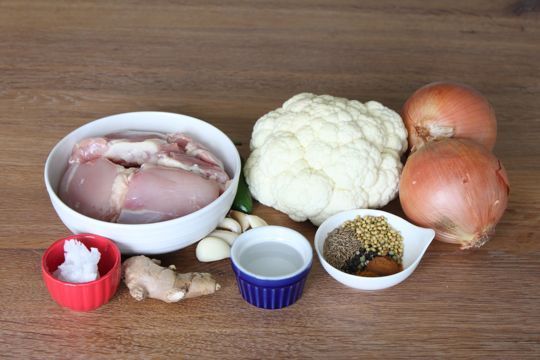
1 teaspoon whole black peppercorns (5 ml)
2 teaspoons cumin seeds (10 ml)
2 teaspoons coriander seeds (10 ml)
1/2 teaspoon turmeric (2.5 ml)
1/2 teaspoon cinnamon (2.5 ml)
1/4 cup white vinegar (60 ml)
8 garlic cloves, peeled
2 1-inch (2.5 cm) pieces of ginger, peeled and finely chopped
2 pounds boneless, skinless chicken thighs, cut into strips about 1-inch/2.5 cm wide (900 g)
2 tablespoons coconut oil (30 ml)
2 yellow onions, finely chopped
5 thin green chiles, stemmed, seeded, and minced or dried red chile peppers
1 head of cauliflower, riced or roasted
Instructions:
Recipe Note: Using whole peppercorns, cumin and coriander seeds give the dish richer, more vibrant flavor. You can, however, substitute the same amount of pre-ground spices.
Toast peppercorns, cumin, and coriander seeds in a skillet over medium-high heat, until lightly toasted, about 2 minutes.
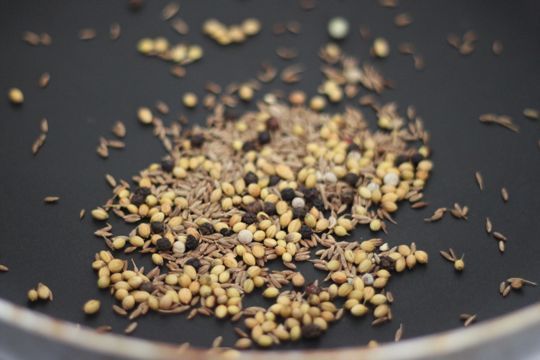
Transfer to a spice grinder (coffee grinder) and let cool then process until finely ground.
In food processor or blender, blend the ground spice mixture with the turmeric, cinnamon, vinegar, half the garlic cloves and a 1-inch piece of chopped ginger until a paste forms. Generously season the chicken with salt then rub the chicken down with the paste and marinate 2 to 8 hours.
Heat the coconut oil over medium heat in a wide saucepan and caramelize the onions until soft and browned, about 25 minutes. Add the remaining garlic and ginger and the chiles. Sauté a few minutes then add the chicken and saute a few minutes more. Add 1 1/2 cups of water. Bring to a boil then cover and simmer over medium-low heat for 25 minutes.
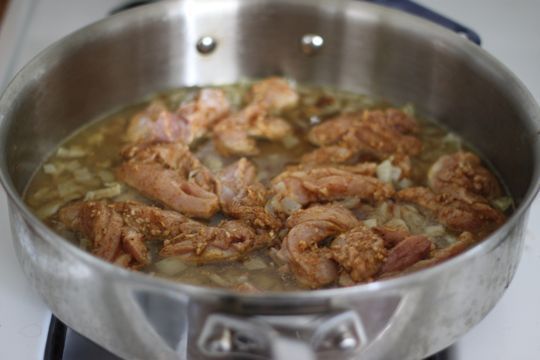
Remove the chicken from the pan and turn the heat up a little, boiling the liquid for 5 minutes so the sauce thickens some.

Not Sure What to Eat? Get the Primal Blueprint Meal Plan for Shopping Lists and Recipes Delivered Directly to Your Inbox Each Week




April 4, 2014
Sick of Counting Calories, Now Hooked on Primal
It’s Friday, everyone! And that means another Primal Blueprint Real Life Story from a Mark’s Daily Apple reader. If you have your own success story and would like to share it with me and the Mark’s Daily Apple community please contact me here. I’ll continue to publish these each Friday as long as they keep coming in. Thank you for reading!
 Hi Mark,
Hi Mark,
First, thank you for your website and books. They have changed me.
I love that you post success stories. I read them when I am having a hard week to help me stay on track. I met my weight goal a few weeks ago and would love for my story to encourage someone to try paleo. I am still working on just being strong and healthy.
I grew up on the American diet and often had unresolved digestive and blood sugar health problems. I can’t blame the doctors since I know they said to keep a food diary (and didn’t jump to expensive procedures).
 Years later I think so many foods were the problem I didn’t see that it was a diet problem (sugar, wheat, pasteurized dairy). From puberty through high school I was always at the top end of my weight range. University (plus lots of fast food) hit and I think I gained 30 lbs during the 1st year, and more so by fall 2007. I was somewhere in the 190 lbs on my 5’ 2” frame.
Years later I think so many foods were the problem I didn’t see that it was a diet problem (sugar, wheat, pasteurized dairy). From puberty through high school I was always at the top end of my weight range. University (plus lots of fast food) hit and I think I gained 30 lbs during the 1st year, and more so by fall 2007. I was somewhere in the 190 lbs on my 5’ 2” frame.
My now husband introduced me to the world of organic food and eventually I became vegetarian. Well, giving up the fast food and a lot of personal stress, my weight dropped off. At 155 lbs a year later, we got married and I started birth control. As soon as I started it the weight loss stopped and I gained it all back. I went off of it a year later at 175 lbs and was never able to make it under the 160s.
While working at an International school in Africa for the last two years, I tried distance running and ended up very ill twice, thwarting my running progress. I gave up during dry season and came home last July for a month. After I realized I had gone up to 177 lbs again and seeing pictures from that summer I started running again. This time though I was continually hungry. It was impossible to make enough health foods, so I started a vicious cycle and if I didn’t run I still ate like I was. Missing a run would set me behind and I just got too overwhelmed dealing with it.

Don’t ask me who told me about paleo. I think I read the name somewhere and looked it up online since I was sick with counting calories. I came across your website and it just clicked. I never liked Atkins because it seemed like non-organic meat and cheese (that didn’t seem healthy), and I watched a lot of people lose and gain it right back. Living in Africa, I would think about what we would have eaten before farming culture. Wouldn’t that make sense? So I got my husband to agree (he hasn’t fully joined) for a month. After that month I was hooked. I was losing and FEELING FULL and great. My skin and hair changed and my blood sugar is great. I rarely feel nauseated and haven’t gotten sick since I started last September.
I started CrossFit around 140 lbs. I seemed stuck there for a bit, but in two months I lost the last 10 lbs plus some. I hit my weight goal of 130 and then continued to lose to 125.
Thank you, Mark, for you website. It changed my life.
This was the last picture taken before I got pregnant. I am 20 weeks along now and so far I have had a perfect pregnancy.

Leah
Like This Blog Post? Dig Deeper with Primal Blueprint Books and Learn How You Can Reprogram Your Genes to Become Leaner, Stronger and Healthier




April 3, 2014
Will We Ever Accept that Exercise is Often the Best Medicine?
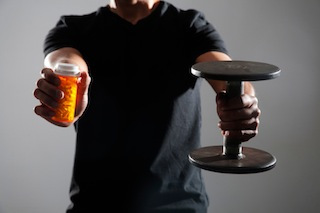 For years, experts have known that in mild to moderate cases of depression exercise is as effective (or more effective) a treatment as prescription drugs. Yet, here we are in 2014, with still climbing obesity rates and higher than ever numbers of people taking anti-depressants – a 400% jump in the last 20 years. This past week, exercise as medical therapy got another round of press after The Atlantic highlighted the issue in their thought provoking feature “For Depression, Prescribing Exercise Before Medication.” Let me add, however, that we aren’t just missing the boat in terms of depression therapy. Research has shown time and again that exercise offers just as good if not better results for an array of medical conditions. I might be preaching to the choir with the general theme, but let’s go beyond the basic assumptions and home in on the critical underlying messages reflecting why exercise isn’t just the safest and often most effective choice but why it so often remains the least accessed therapy.
For years, experts have known that in mild to moderate cases of depression exercise is as effective (or more effective) a treatment as prescription drugs. Yet, here we are in 2014, with still climbing obesity rates and higher than ever numbers of people taking anti-depressants – a 400% jump in the last 20 years. This past week, exercise as medical therapy got another round of press after The Atlantic highlighted the issue in their thought provoking feature “For Depression, Prescribing Exercise Before Medication.” Let me add, however, that we aren’t just missing the boat in terms of depression therapy. Research has shown time and again that exercise offers just as good if not better results for an array of medical conditions. I might be preaching to the choir with the general theme, but let’s go beyond the basic assumptions and home in on the critical underlying messages reflecting why exercise isn’t just the safest and often most effective choice but why it so often remains the least accessed therapy.
Yes, the whole picture is profoundly intuitive to any Primal type (or maybe anyone not sold on the pharmaceutical solution to living). Isn’t it a funny, head-scratching coincidence that basic exercise can prevent – and treat – psychological and physical decline? Who would’ve thought that movement was useful to our bodies – that offering our physical forms the activity they were designed to perform for eons would confer some actual benefit? Still, the actual results themselves are fun if not impressive to read. Consider this…
Regular exercise resulted in a 30% remission rate for those with depression who didn’t respond to SSRI medication.
Study participants with heart disease who exercised had the same risk of dying as those who took popular drugs such as statins, antiplatelet drugs or ACE Inhibitors.
Research subjects with prediabetes who took the array of common prescription medications had the same mortality risk as those who simply exercised.
Among study subjects who had experienced stroke, those who exercised had a significantly lower mortality risk than those who took medications such as anticoagulants and antiplatelets.
On the flip side of this coin, of course, are the negatives. We’ve established that exercise confers physical, cognitive and emotional advantages for the prevention and/or treatment of many medical conditions. Add to this equation the question of drawbacks. Does exercise have disadvantages? In all fairness, your hair gets messed up. You’ll likely sweat. You perhaps need to take an extra shower or time the day’s toilette to match your workout schedule. You need to buy a pair of shoes (but then again you can just go barefoot). You’ll need to invest a little time for heavier workouts but perhaps can try to get some of the low level movement in while using a handy-dandy treadmill desk (or, more old school, work a job with heavy manual labor or lots of activity). Then we come upon the whole inertia argument, but in response there are even effective exercise options for the motivationally challenged.
While I’m not trying to minimize the nuisance of smelly armpits or losing an hour on the sofa, let’s take a look now at the potential downsides of pharmaceutical solutions.
Side Effects for SSRIs: gastrointestinal disturbances, anxiety, agitation, insomnia, sleep disturbance, weight gain, sexual dysfunction
Side Effects for Statins: memory loss, forgetfulness, confusion, muscle damage, increased risk of diabetes, liver injury
Side Effects for Anti-coagulants: excessive bleeding, severe bruising, bloody urine or stool, headache, back pain, chest pain, difficulty breathing
Side Effects for ACE-inhibitors: dizziness, headache, fatigue, loss of appetite, gastrointestinal problems, diarrhea, numbness, fever, joint pain
Side Effects for Beta-blockers: diarrhea, stomach cramps, nausea, vomiting, rash, blurred vision, muscle cramps, fatigue, headache, depression, confusion, dizziness, sexual dysfunction, low or high blood glucose
The final kicker? A study out just last month showed that more than 20% of older adults being treated for multiple medical conditions are prescribed medications that worsen the symptoms of another condition. In other words, their medications work at odds or in “therapeutic competition” with each other. The more we dig ourselves into the pharmaceutical hole, it appears, the worse (and more ironic) it all gets.
Knowing all of this, why does the obvious solution feel so impossible? Why won’t people accept exercise as a genuine medical option? Why do we tend to go with a pill (at times, an awfully expensive one) rather than a simple, natural behavior change? Why are we individually invested in this choice? Why are we as a culture – or medical establishment – so invested in this approach?
We’ll spend billions of dollars researching which gene “lights up” or which protein levels rise all in the name of better understanding the physiological mechanisms of disease while the solution itself is staring us in the face. Let me back up for a moment and suggest that I’m not arguing that exercise covers any and all medical need. I’m not saying it has the absolute power to cure or prevent any particular person from developing illness in his/her lifetime. Our physiology is inherently complex. People should avail themselves of the broad medical options that allow them to lead the fullest and healthiest lives possible. That said, there’s rarely an instance in which lifestyle choices can’t make a powerful difference either unto themselves or in conjunction with conventional or complementary medical treatments.
The million dollar question in all this, of course, is how do we get people to accept exercise as a treatment? How do we convince doctors to literally prescribe exercise (understanding, of course, that some already do)? How can patients be convinced to avail themselves of the safest, perhaps most effective treatment option? The Atlantic feature chose to address this question from the perspective of psychiatrists. Their answer? To treat it “like real medicine.” For one psychiatrist interviewed, that means addressing it in his appointments with patients as he would a prescription for medication, discussing the details of studies that support the effectiveness of exercise, talking about effective “doses” and intensity levels, emphasizing the importance of consistency by comparing it to a diabetic’s occasional versus regular use of insulin.
It’s a provocative thought. What if doctors talked about exercise as medicine in their sessions? Would it be convincing to the majority of people who walk through their doors? (Would it win you over?) The results, according to doctors in The Atlantic piece, seem mixed. The most difficult factor is the obvious elephant in the living room – that the pill is there ready to be prescribed, whether it’s called “a last resort” or not. Nonetheless, can the rhetoric sway at least some people to take exercise to heart? Will homing in on the technical details of dosage and variety get people to take the usually friendly advice as medical law – and personal treatment plan?
There’s an interesting wrinkle to this that I don’t often see discussed with how we tend to downplay the value of lifestyle interventions. Research into the placebo effect demonstrates that the more costly we believe a certain placebo “medication” is, the higher we rate its “effectiveness” in treating our symptoms. The value we attach to a treatment influences the actual results we think we experience.
This point, in turn, brings up another dimension. While we (rightly) exalt the everyday accessibility of exercise, are we simultaneously downgrading its appeal to those who need it most? Let’s just brainstorm for a minute. What would happen if doctors could prescribe personal training and/or fitness center/class use as they do physical therapy? People often skip physical therapy or bow out before they’ve met their goals, but generally people take advantage of it when a doctor orders it. Would it boost people’s buy-in if we promoted general fitness training and support the same way? Are we kidding ourselves to think we can put the onus solely on the individual when the system so clearly supports the opposite choices?
There’s an interesting cultural dichotomy at work here. I think a lot of ordinary people would bristle at the suggestion that they need a trainer or that this person’s service should cost them in treating their illness. Yet, they think nothing of spending as much or considerably more on medications than they would the guidance (and motivation) of a personal trainer. Simultaneously, there’s an odd fascination with the most extreme representation of the trainer figure as millions watch Jillian Michaels et al. every week in the disturbing entertainment of televised panopticon meets “fat camp.” We’re a confounding, nonsensical populace (collectively speaking)….
On the other end of the “medical speak,” when prescribing exercise is the self-care justification. You deserve to take care of yourself. You deserve to thrive. You deserve to not have to take insulin every day or deal with the complications of statins. Is this line of reasoning any more convincing for people than dosing out activity according to medical study suggestion? My own sense is it depends on the patient.
Either way, it always intrigues me how put out we are by our bodies’ needs. Are we naturally this lazy, or has the culture just gotten to us that we feel so put upon having to exercise ourselves – having to make the effort to pick up our 100 lb gym shoes and walk out that 1000 lb front door to go for a walk? That hour we have to “waste” on fitness could’ve been used for three dozen other, more pressing needs. Why not see a pill as the ultimate “easy button” that allows us to have it all. It’s hard to kick the collective faith in that assumption even if the research suggests a much different picture. Where does medical logic fit in a modern mindset? It’s hard to tell, but the simple Primal perspective as always holds – that we naturally live through our bodies and have the ability to physically and psychologically thrive when we offer ourselves the age-old inputs our genetic blueprints anticipate. Maybe Primal logic’s time has come.
Thanks for reading today, everyone. What thoughts does all this raise for you? Is there any clarity or direction to be found in how to prescribe movement over medicine?
Get the 7-Day Course on the Primal Blueprint Fundamentals for Lifelong Health Delivered to Your Inbox for FREE




April 2, 2014
Resistant Starch: Your Questions Answered
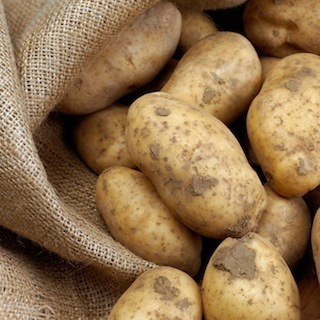 Last week’s Definitive Guide to Resistant Starch garnered a lot of attention. While the article covered a lot of ground, many of you had lingering questions and concerns about the topic: What is and isn’t resistant starch? How much resistant starch should I be eating? Why is resistant starch good for me? What is resistant starch again?
Last week’s Definitive Guide to Resistant Starch garnered a lot of attention. While the article covered a lot of ground, many of you had lingering questions and concerns about the topic: What is and isn’t resistant starch? How much resistant starch should I be eating? Why is resistant starch good for me? What is resistant starch again?
I don’t blame you; it’s a confusing one that appears, on first glance, to challenge some of the fundamental Primal ideas about food and nutrition.
Today, I’m going to answer as many questions from last week as I can. Hopefully it clears up most of the bigger questions.
Let’s get right to it:
Do the benefits of RS outweigh the negatives of rice, legumes, potatoes, etc.?
Great question.
Rice and potatoes, yes. I’ve already spoken on both those subjects in previous posts, and my basic conclusion is that both rice and potatoes are relatively toxin-free sources of starch that an insulin-sensitive, sufficiently-active individual can likely consume in moderation without ill effect. For both foods, the negative effects come from the carb load they represent, which is simply too high for some people. But by cooking and cooling them, you reduce the carb load, reduce the glucose response, and improve your insulin sensitivity. In essence, any “negatives” are mitigated by the emphasis on resistant starch. If you have trouble with glucose tolerance, and you’re looking to drop weight, you should still exercise caution with these foods and heed the Carb Curve, but preparing them in a way that increases the RS content will only make them less problematic.
One note: potatoes are iffy for people with nightshade intolerance. So there’s that to consider.
Legumes, I’m not sure. I strongly suspect that the health benefits ascribed to legumes are solely due to the prebiotic, RS effects, which interest me but are not the sole province of the legume. But the fact remains that many people simply don’t tolerate legumes very well. It could be that some of the tolerance issues stem from disrupted gut flora and introducing RS will ameliorate your troubles, but who knows? We’re still learning a lot. In the meantime, I’m not too interested in soaking beans. There’s nothing essential about them, so long as we’re getting RS from other sources.
I’m a little confused…how does one go about adding RS in whole food form without doubling or tripling their normal daily carb intake? I can’t see eating 1-2 green bananas and a couple raw potatoes each day, in addition to normal amounts of carbs from veggies and fruit (I usually have one serving of fruit a day– berries, if possible) and still staying under 100-150 carbs. Please, enlighten me!
Believe it or not, you can easily eat green bananas without tripling your digestible carb intake. And that’s the key: you don’t digest these carbs, your gut flora do. An average large banana contains a hair over 30 grams of carbohydrate. If it’s green and totally unripe, the majority of that carbohydrate will be resistant starch that your body does not digest into glucose.
You’ll know you’re getting the good stuff when the banana is crispy and leaves a chalky aftertaste in your mouth. Pleasant, I know. But added to a smoothie, it’s actually quite nice. In fact, here’s a recipe I’ve been playing around with:
Cup of milk (coconut, almond, cow, goat, etc)
Large green banana, peeled and sliced
Quarter teaspoon of vanilla extract
Quarter teaspoon of cinnamon
Half teaspoon of honey (may be unnecessary depending on the sweetness of your bananas)
I assume that the time of day you take RS does not matter?
It shouldn’t. Once you’ve established a healthy population of butyrate-producing gut bugs, they don’t need to be fed at a certain time every day. They’re quite malleable and adaptive, and they’ll also begin feeding on other fermentable fibers in your foods.
What is the reason to supplement RS instead of getting it from food? How much RS is “good enough” and how much real food would meet that amount?
Supplemental RS is just easier, and most of the research in support of it has used supplemental RS-rich powders – so we know it works. But real food probably works even better since it comes with vitamins, minerals, and polyphenols (which have prebiotic effects in their own right), and it most closely resembles the way our early ancestors consumed RS.
Let’s see. If you can work your way up to between 30 and 40 grams of RS, whether from food or from powders, you’ll be in a good place. That’s the dose used in much of the research, and it’s where butyrate production is maximized.
What does that look like in food form?
600 grams of baked, then cooled, potato has around 25 grams. You can even lightly heat the potato after it’s been cooled and retain the RS.
1 large (8 inch) green, fully unripe banana has somewhere between 20-25 grams. A large green plantain has about 50 grams. Not the most palatable, but it’s doable, especially if you slice into discs and dehydrate into chips. A smoothie masks it well, too.
Any idea if heating the potato starch (like using it as a thickening agent in soups/stews) negates its RS function?
Yes, the RS will be completely negated. Sorry. It does make a good thickener, though.
Cooked and cooled rice – as in sushi? Or does the vinegar somehow negate the benefit of the resistant starch?
Yes, cold sushi rice will contain RS. Good sushi restaurants generally keep their rice at room temperature, though, so I’m not sure you’ll get the retrograde RS effect unless you go for grocery store deli case sushi. And hey, I actually like that stuff, so there’s no shame in eating it. Just avoid gas station sushi if you know what’s good for you.
Vinegar shouldn’t affect it either way. Vinegar does reduce the blood glucose response when consumed with carb-rich foods, so it might be a nice supplement in its own right if that’s an effect you’re after.
So that pizza crust recipe has mostly tapioca starch/flour (same) in it. (Also, not Potato Starch–potato flour) If I make the crusts and freeze them and then reheat and eat, would the RS still be usable? Same as the potatoes and rice I would think. So perhaps that is a go on the RS.
I don’t think it works like that. For retrograde RS to form, it has to be in its whole form – potatoes, not potato starch; cassava, not tapioca starch; rice, not rice flour.
Question about “cooked and cooled” – what the heck does that mean? So, I cook it, and cool it. Does that mean I have to eat it cold to get the resistant starch? If I zap my bowl of bean soup and rice that came out of the fridge, when does it lose the resistance to digestion?
Retrograded RS (cooked and cooled) is maintained during subsequent heating. You can even heat it and cool it once again to create even more RS. So you don’t have to eat it cold, though I would advise against re-heating a cooked and cooled RS source into oblivion. Keep the heat relatively low.
Should the carbohydrates from resistant starches (for example, a cooked and cooled potato) still be counted in daily consumption if it is not digested?
Some of it should still be counted, because not all – or even most – of the starch is resistant. Most of it is good old digestible glucose. But you can subtract the 4-5 grams of RS from the 21 grams total starch in every 100 grams of cooked and cooled potato. Not bad, eh?
And remember, it’s not that the 4-5 grams become inert, useless matter passing through your body. They are bioactive, just not with the biology of the host. They turn into fatty acids that fuel your colon and improve your ability to tolerate the digestible glucose you consumed along with them.
Is just eating Pistachio’s (or other seeds) enough RS to do the trick?
Probably not. To hit the 30-40 grams of resistant starch that maximizes benefits in most trials with pistachios would require a lot – of money, of calories, of shelling. 100 grams of roasted pistachios has around 3.5 grams of RS. That may be in the shell, and raw pistachios may have more, but either way it’s not a huge amount. Not bad, not great. The beauty of the less calorically dense RS sources is that they allow a more varied diet. It’s nothing to add a couple tablespoons of potato starch to your diet.
That said, pistachios are potent prebiotics. One recent study found that they increased butyrate-producing bacteria in the colon, outperforming almonds. You should definitely eat pistachios, but I think you should also eat other more concentrated sources of RS.
That’s the beauty of it all: it’s not a competition! We can eat pistachios and other things at the same time without disrupting the effectiveness of either.
Question: would hummus fit the bill as cooked & cooled legumes?
Yes, hummus seems to qualify even though it’s not Primal. According to the PDF from last week’s post, 100 grams of hummus has 4.1 grams of RS. Hummus made from soaked chickpeas will have more than hummus made from canned chickpeas, however.
What would be the best way to gradually incorporate RS into the diet for a person that has gut inflammation with chronic bloating?
You need probiotics. And in your case, I doubt yogurt or even kefir will be sufficient. Try something soil-based, as in the same types of probiotic organisms that Grok was getting on a regular basis simply from living. These are likely the microbes to which our guts are evolutionarily accustomed.
Primal Flora works (worked for me with RS!); it provides a high dose of two specific soil-based strains that have been shown to be helpful in clinical trials. You could also go more broad-spectrum, with more soil-based strains but lower concentrations.
Start really, really, really small with the RS. If you’re going with the unmodified potato starch, start with 1/4 to 1/2 a teaspoon. It will look like almost nothing. Increase it by 1/4 tsp slowly as comfort allows.
If that doesn’t work – but I imagine it would – and your gut is really compromised, I suggest trying Dr. BG’s gut healing protocol. It involves probiotics, prebiotics, and a number of other, more drastic but potentially necessary steps. The good doc is a bit wild, but in a good way. Just read her stuff at least twice and you’ll figure it out. Reading it out loud seems to help, too. She certainly has a way with language!
Does this mean I can start eating sushi and potato salad??!

Well, you can choose to eat anything you want, of course. That’s never changed. What this does indicate is that those foods, when cooled, have unique effects, different than if you were to eat a bowl of hot steamed rice or a large baked potato fresh from the oven.
The preponderance of evidence suggests that the potato salad and the cold sushi rice will result in a lower blood glucose response and feed the helpful critters in your gut – both good things. But before you go digging into that store bought potato salad on a regular basis, consider avoiding the seed oils and making your own. I’m a fan of lemon juice, olive oil, salt, and fresh herbs, myself. I can rarely be bothered to make my own mayo, although that’s also a good option.
Anyone have a recipe using raw potato starch that can be easily incorporated into a primal/paleo diet (meat, eggs, veges, occasional fruit)? I don’t do smoothies, nor do I do fruit juice or yogurt.
Aside from smoothies, sparkling water is the best vehicle I’ve found for potato starch. The bubbles seem to enhance the dispersal of potato starch granules into the medium, even without a blender. Just a fork or even a quick stir with your index finger is enough to get it completely mixed in.
So what to use? Bob’s Red Mill Potato Starch or Bob’s Red Mill Tapioca Flour?
Potato starch seems to be the most reliable way. From reading the comment sections on blogs and posts on various forums, the digestibility of tapioca starch/flour varies from person to person. Many people seem to get elevated blood sugar after taking a tablespoon or two of the tapioca, whereas potato starch is almost invariably indigestible.
Can the potatoes be fried in lard and then cooled? I would rather try a yummy food source then a powder.
A few weeks back, I described my method for foolproof, easy crispy root vegetables. You pre-bake them and store in the fridge. This increases the RS content of the potato. When you’re ready to fry them, simply peel the skin, cut them up into the desired shape (cube, fry, etc), and lightly pan fry them in the fat of your choice. Lard is a great option. Since they’re already cooked, you don’t need a lot of heat or a lengthy cooking time, and the RS is preserved.
If we’re taking probiotics without RS as well – what is happening? The bacteria in the probiotics are starving? But don’t they eat other stuff besides RS? Sorry, I know I sound like a boob, but – I’m still a little confused.
No, the probiotics can still help, by partial colonization. But for the best results, you’ll want to provide food so that the probiotics have more lasting power and can hitch a ride into the colon where they do the most good. Feed the animals; they aren’t bears and it’s not Yellowstone! It can be resistant starch and/or any other prebiotic fiber. The point is to feed them stuff they can eat, thrive on, and ride on.
RS fits the bill.
One more question – how does this need for RS fit into the Grok-lore? What did our Paleo ancestors do that we aren’t doing?
As I’ve written before, wild tubers, roots, and other underground storage organs are frequently highly fibrous with lots of indigestible starch. That’s what Grok would have encountered, not the smooth, starchy goodness of a Russet potato, which had to be selected for by the experienced hands of agrarian tuber breeders.
We can’t all eat dirt-encrusted cattails rich in resistant starch, but we can approximate the effects with modern tools. Taking soil-based probiotics and emphasizing preparation methods that maximize resistant starch content is, by all accounts, an extremely Primal and biologically-appropriate way to emulate one important aspect of our evolutionary metabolic environment.
Any thoughts on the resistant starch found in Quest Bars? Quest Bars contain isomalto-oligosaccharides. The makers claim this is a resistant starch.
It’s not a resistant starch per se, but rather a prebiotic fermentable fiber. Studies indicate that while its consumption does improve constipation and increase production of the short chain fatty acids (SCFAs) propionate and acetate, it does not increase production of the most beneficial SCFA, butyrate.
Is consuming RS the only way to feed our gut?
No, definitely not. Other prebiotic substances matter, like various plant fibers (inulin, pectin), dark chocolate, and even connective tissue (yes, animal fiber - the crunchy gristle and cartilage too many people discard). With a Primal eating plan rich in plants and whole animals (including bones and broth), you should be getting plenty. But resistant starch is an important, unique prebiotic that makes feeding our gut a whole lot easier and more effective.
That’s it for today, folks. Thanks for reading!
Get the 7-Day Course on the Primal Blueprint Fundamentals for Lifelong Health Delivered to Your Inbox for FREE




April 1, 2014
11 Surprisingly Effective Exercises You Can Do Without Being “That Guy” in the Office
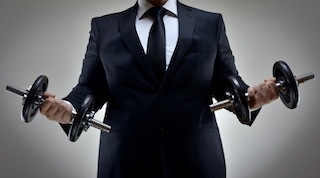 By now, the call for lots of low level activity has seeped into the mainstream. Every other week, it seems there’s an article in Slate or the Atlantic or your local news explaining how sitting is bad for us, or puttering around in the garden is good for you, or simply exercising a few times a week while languishing on the couch or at your desk isn’t enough to stave off physical degeneration. That’s great, but the fact remains that most of us reading this are spending the better part of our waking lives in an office or at a desk. We’re getting paid to stay in the same location all day, so getting “lots of slow movement” isn’t always possible or easy.
By now, the call for lots of low level activity has seeped into the mainstream. Every other week, it seems there’s an article in Slate or the Atlantic or your local news explaining how sitting is bad for us, or puttering around in the garden is good for you, or simply exercising a few times a week while languishing on the couch or at your desk isn’t enough to stave off physical degeneration. That’s great, but the fact remains that most of us reading this are spending the better part of our waking lives in an office or at a desk. We’re getting paid to stay in the same location all day, so getting “lots of slow movement” isn’t always possible or easy.
What are we to do?
There are lots of “Top X Exercises to Do at the Office” lists out there, but most of them contain excessive fluff – exercises that don’t really qualify, that won’t really help you get or stay fit. How many of you are really going to sit there doing toe raises at your desk all day?
The problem with exercising at work and making it count: there’s a fine line between staying active and being “that guy.” You know, that guy. The one doing air squats at his desk every ten minutes. The girl doing pushups in the breakroom. The guy wearing a weighted vest as he gives a presentation. That’s all fine and good, and it’s okay being the crazy guy (wearing FiveFingers!) in the office, but sometimes we want to play it cool and blend in a bit, especially in a professional environment.
If you’re going to be active around the office, you might want to do it in a covert manner. Or, at least, not so overt that you make everyone uncomfortable and shower your co-workers with (an admittedly refreshing) sweat mist. Let’s explore a few ways we can stay active at the office without wasting our time or looking ridiculous:
The Stairs
The stairs are your best friend. They’re usually off to the side, away from the rest of the office. They are vertical and require opposing gravity in order to climb them. The most basic way to exercise on the stairs is to take them. Avoid the elevator and just take the stairs when you need to go somewhere. Just that simple switch is enough to see improvements in body composition and cardiovascular markers, but there’s also more you can do.
1. Stair Jumps
Plyometric exercises like box jumps are great, but jumping down from the box as many times as you jump onto it can do a number on your joints if you’re not careful. By using the stairs, you’re never jumping down. You’re always going up. That makes it harder (for your muscles, stamina, etc) but easier (on your joints and connective tissues).
Switch it up: Try single leg jump, single leg landing; single leg jump, double leg landing.
2. Loaded Stair Ascension
This time, you’re going to walk the stairs. Sounds easy, right? Try walking the stairs while carrying something heavy, like a box of printer paper. If your office has gone exclusively electronic, maybe it’s a box of tablets or something. Or a willing co-worker (or, for a tougher workout, a non-willing co-worker).
Switch it up: Skip a step or two as you climb, turning a simple loaded stair walk into a walking stair lunge. Change how you hold the object, too – overhead with two hands, overhead with one hand, in the front rack position, on either shoulder, out in front of you.
3. Stair Sprints
“What? Oh, don’t mind me! I’m just late for a meeting,” you can say as you whiz past confused co-workers in the stairwell. It’s fine if this happens multiple times in a single day, because hey, you’re a busy guy. So as to avoid excessive sweating and/or panting (thus giving up the ruse), keep your rest intervals long enough to fully recover. Sneak away for a single sprint every hour, maybe. That sort of thing.
Switch it up: Try not skipping steps, which is actually tougher to do for some people when they really get moving on stair sprints. It also adds a bit of balance, agility, and coordination practice.
At the Desk
Standing/walking/cycling desks are obviously ideal, but they’re still rare in the wild. The following exercises can all be performed while using a traditional sit-down desk – you know, that place you spend most of your time.
4. Faux Sitting
Engage your glutes and raise yourself up in your chair by about an inch, so you’re just hovering over the chair in a squat position. Hold that squat for as long as you can. Passers-by will just assume you’re furrowing your brow because you’re working so hard. They’ll never suspect that you’re exercising.
Switch it up: Do it single-legged. Lightly, slowly, almost imperceptibly bounce up and down.
5. Elevated Sits
Kind of like L-sits, except you keep your knees bent as if you’re sitting in the chair. Grip either side of the chair and hold your body up off of it an inch or so, using just your hands. Try to keep your elbows straight and shoulders back. If you don’t care who’s watching, feel free to turn it into a legit L-sit. Keep a toe lightly on the ground to handle some of the load if it’s too much.
Switch it up: Stack some books on your lap to increase resistance.
6. Isometric Contractions
Even though it sounds like it wouldn’t work, voluntarily contracting your muscles as hard as you can and holding it can increase strength and size. In a 2013 study, researchers asked trainees to do the following training regimen: hold your elbow at a 90 degree angle and flex your biceps and triceps as hard as you can for four seconds followed by four seconds of rest; do this for 5 sets of 10 contractions, three days a week for 12 weeks. After 12 weeks, trainees had increased extension and flexion strength and added 4% to the size of their biceps and triceps. You don’t have to make this your sole workout routine, but it wouldn’t hurt to do a few contractions during downtime just to keep your muscles primed.
Switch it up: Try doing the same with your legs.
7. Desk Lifting
Lift your desk ever so slightly and hold it until your biceps can’t take anymore. Or if your desk is bolted down, or too heavy to lift, attempt to lift it. This may turn into a kind of isometric contraction like the previous exercise, and that’s fine. Use caution. We don’t want any broken computer monitors reported.
Switch it up: Use your legs instead of your arms.
8. Resistance Band Shoulder Abductions
This one is obviously an exercise, but the results of a recent study were so compelling that I had to include it. Researchers took two groups of office workers with frequent neck and shoulder pain and had one group do resistance band shoulder abductions (video here) for two minutes a day for 10 weeks. The control group merely got health advice for fifteen minutes a day over the same period. In the exercise group, complaints of neck and shoulder pain dropped by 40%, while strength increased by 6%. No such effects were seen in the control group.
Switch it up: No band? Do isometric abduction contractions against the desk using the same arm/shoulder position.
9. Stand Up
Yep: just stand up. Stand up from your chair and sit back down. Do it a couple more times. Do it again in two minutes. Stand up at least once a minute. There are many ways to do it. The important thing is that you work against gravity on a regular basis. It’s not hard, and you don’t have any real excuses not to. So stand up. Often. It’s probably more effective to do this throughout the day, rather than do a single set of 50 stand ups.
Switch it up: Stand up with one leg, sort of a mini one legged box squat.
Active Alternatives to Standard Office Activities
We all do these tasks every single day, so why not make them a bit more active? Many of the tasks we mindlessly submit to every day can actually be modified to support an active lifestyle.
10. Walking Meetings
Next time you’re setting up an informal meeting with your team, ask if they’d like to go for a walk instead of sit in a room. There’s good research suggesting that walking improves cognitive function, so walking meetings can conceivably be more productive than sitting meetings.
Switch it up: Too cold or wet to walk outside? Too weird to pace up and down the same hallway with your group? Standing meetings are a worthy alternative to walking meetings and far superior to sitting.
11. Face to Face Pings
You could shoot that email, send that IM, or send that text… or you could get up and walk over to the person you’re trying to reach. Seriously, they’re right there, fifty steps away. Why not walk over and get some face to face contact?
Switch it up: Sprint over to the person. Okay, sprinting may be starting to look more like exercise, but there’s nothing wrong with a little urgency in your interpersonal communications.
And that about does it for the list of effective exercises you can covertly perform in the office. You can certainly do more effective exercises – like air squats, chair dips, or pushups – but you’ll end up being “that guy.” Other covert exercises – like partial calf raises performed from the safety of your office chair – exist, but they frankly aren’t worth the effort.
What about you guys? How do you stay active at the office without being the weird one?
Thanks for reading, all.
Get the 7-Day Course on the Primal Blueprint Fundamentals for Lifelong Health Delivered to Your Inbox for FREE




March 31, 2014
Dear Mark: Nausea After Fast Breaking, Thumbless Pushup Alternatives, Chewing, Sour Cherry Juice, Yacon Syrup, and Mid-Distance Running
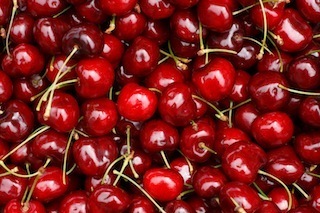 For today’s Dear Mark, I’m answering a bunch of your questions rapid fire-style. First up, I discuss why a person might experience nausea after breaking a 24 hour fast with a meal. Second, I explore some pushup alternatives for a guy with terrible thumb arthritis. Third, I explain the importance of chewing for jaw development, dental health, and digestion, and for the last three, I give my take on sour cherry juice as a health supplement, yacon syrup as a Primal sweetener, and middle distance running as an acceptable form of exercise.
For today’s Dear Mark, I’m answering a bunch of your questions rapid fire-style. First up, I discuss why a person might experience nausea after breaking a 24 hour fast with a meal. Second, I explore some pushup alternatives for a guy with terrible thumb arthritis. Third, I explain the importance of chewing for jaw development, dental health, and digestion, and for the last three, I give my take on sour cherry juice as a health supplement, yacon syrup as a Primal sweetener, and middle distance running as an acceptable form of exercise.
Let’s go:
Mark,
I have been fasting for 24 hour periods once or twice a week. I feel great during the fast but have had some terrible nausea upon breaking the fast. Why is that and what do you suggest?
Steve
You’re probably eating too large a meal to break the fast. I realize that the urge to gorge is powerful when you’ve just gone an entire day without food, but realize that you might not be equipped to eat a 2000 calorie meal right off the bat.
Low stomach acid is another possibility. Nausea after eating is a typical symptom of low stomach acid. Without sufficient stomach acid, you simply can’t digest your food properly or completely, and nausea is a byproduct of that. If you’re eating big, fast-breaking meals, low stomach acid will become even more apparent.
Timing of the meal matters, too. Stomach acid production follows a circadian rhythm, tending to be lowest in the morning and highest at night in healthy people. It also increases in response to meals, but if you’re fasting for the entire day you’re essentially starting from baseline, and that can hamper your digestion.
Mark,
I just finished reading your article on body weight exercises. I have basal joint arthritis which won’t allow me to do pushups or anything pushups related. It’s really discouraging when you are trying to workout to lose weight and almost every workout you can find concentrates so much on pushups. I’ve only made it a little ways into your book but is there anything that you have that could help?
When I do a workout with pushups, if I make it to the end without giving up because of pain. I will be out of action for 3-4 days until the swelling goes down. Thanks
Dan
For those who don’t know, basal joint arthritis is arthritis of the thumb joint. It can make simple tasks, like opening a door or writing with a pen, difficult and painful. Pushups place a lot of pressure on the thumb joint, so it’s not surprising that you can’t really do them without pain.
First off, don’t do standard pushups. Don’t do anything that causes swelling and debilitating pain.
Second, try doing pushups on your fists. It’s pretty simple. Make a fist, place them on the ground (like you’re punching it), and perform a pushup. The thumb is tucked inside and doesn’t even really get involved at all. There are some advantages beyond the basal joint arthritis relief:
Greater range of motion. Using your fists adds a few inches to your pushup depth. I always find that the extra couple inches are the hardest – and offer the most bang for your buck. As long as your shoulders are healthy, you should be okay going a little deeper.
Better distribution of weight. When people do pushups on their hands, it’s common to push through the fingers rather than through the heel, thus placing a lot of stress on the wrists and hand. On your fists, you form a single, coherent, stable line from your fists up through your forearms. This makes you stronger and the movement safer.
If fist pushups don’t work, you can try carefully doing dips. Don’t grip the bar or ring, though. Instead, balance on and push through the heel of your hand without using your fingers or thumbs. This requires some extra balance but it does take pressure off the thumb. Dips are normally considered to be a tricep exercise, but leaning forward just a tad can really hit your chest.
Also, if there are any other “pushing” exercises you can do comfortably, like the aforementioned dips, or overhead presses, or even bench pressing, those are fine, too. You can definitely get by with “just” a horizontal or vertical push.
In paleolithic times, I imagine Grok did a fair amount more chewing than we do in today’s age. I’ve noticed that I can go days and days without actually chewing anything substantial. Everything is cooked, pulverized, mashed, blended and otherwise made to hardly need any chewing. Even a lot of meat these days goes down without hardly any chewing. Does this matter to our teeth, to our jaws, to our digestion, or for any other reasons?
Corey
Oh, yeah, chewing matters.
Chewing is extremely important for jaw development. Several studies show that populations of children raised on coarser, tougher foods (like reindeer jerky, whole meal bread, and gritty maize) display wider palates, longer faces, and larger mandibles than children raised on puréed or otherwise soft foods. Examining the skulls of hunter-gatherers (coarser food) and early agrarians (softer food) reveals similar differences, with the former showing longer mandibles with plenty of room for tooth eruption and the latter showing shorter mandibles with crowded teeth.
Chewing increases saliva production. Saliva is mechanically useful – it “washes” your teeth to keep food off and harmful bacteria from taking up residence. Saliva also contains anti-bacterial and immunological compounds that serve as another line of defense against cariogenic microbes and the plaque they form. And finally, salivary digestive enzymes represent the first line of digestion. The more you chew, the more your food will be “pre-digested” by salivary enzymes.
Hi Mark,
I’d love to hear your thoughts on tart cherry juice as a supplement for cortisol reduction, and/or as a sleep aid.
I’m a bit concerned about the sugar content per serving, but trying to determine if it really is beneficial in the fight against belly fat.
Thanks,
Gary
Well, I love cherries. One of my favorite fruits, in fact. Apart from being delicious, they’re also quite nutritious with a fair bit of research supporting their inclusion in our diets:
Cherry consumption is strongly correlated with a lower risk of recurrent gout attacks in patients with gout.
Cherries are rich in phenolic compounds and feature a very high antioxidant capacity, especially the red varieties.
What about sour cherries?
Sour cherries are higher in anthocyanins (the same kind of compounds found in blueberries and other colored produce), which may have neuroprotective effects.
Sour cherry juice reduced oxidative stress in healthy older men and women, but the dosage was rather high – almost half a liter of CherryPharm a day. That could get really expensive.
Sour cherry juice performs only modestly as a sleep aid in insomniacs, about as well as melatonin and worse than hypnotherapy and other cognitive behavioral therapies. One study did find that in otherwise healthy people, sour cherry juice does seem to increase urinary melatonin levels and improve sleep.
Sour cherry juice retains these compounds, so it could be generally helpful as an antioxidant supplement. And it may be able to improve sleep by a little. But for belly fat reduction via stress mitigation or sleep improvement? No single food or supplement is going to do that. Don’t guzzle cherry juice while cruising the Internet at midnight and hope it’ll improve your sleep. Don’t buy an expensive sour cherry supplement and assume it will override the big things you’re not doing.
Definitely eat cherries, though.
Hi Mark,
I was wondering if you could do a post about Yacon Syrup. It seems to be pretty popular in Paleo circles as a low GI sweetener and just wanted to get your take on it.
Thanks!
Augustina
I haven’t used it myself (don’t really do sweeteners, except for a jar of honey I keep around just in case, and the small amount of sugar in my morning coffee), but I looked into it.
Yacon syrup comes from the yacon tuber, an Andean crop that’s commonly used as a food tuber in South America. To make syrup, the tuber is juiced, the pulp removed, and the liquid reduced and concentrated. As sweeteners go, it’s a non-industrial way of doing things. No harsh chemicals involved (PDF).
The result is a sweet syrup that tastes a bit like molasses or brown sugar (again, I haven’t tried it; just going on others’ reports) while having, as you said, a low glycemic index. Yacon syrup is low GI for two reasons: it contains a large amount of inulin, a fructooligosaccharide (FOS) that tastes sweet but is not digested in the small intestine and instead acts as a prebiotic fiber; and it contains a fair amount of fructose, which does not provoke a strong glucose response. Depending on the product, a tablespoon of yacon syrup has roughly 7 grams of fructose and can be up to 50% prebiotic FOS.
There’s very little research specific to yacon. In one small 2009 study, researchers found that daily yacon syrup reduced belly fat in obese women with insulin resistance. And in 2008, yacon syrup reduced transit time in healthy people. However, since we know that prebiotics are generally good and even necessary for our guts, and recent evidence in mice shows that FOS derived from yacon can improve gut immune parameters and may reduce the risk of autoimmune disease, I’d wager that yacon syrup is safe and even beneficial.
That’s not to say other, better, more affordable sources of prebiotics don’t exist. Garlic, onions, leeks, jicama, and jerusalem artichokes are all excellent sources of inulin, while most other plant foods contain some modicum of fermentable prebiotic fiber. And then there’s resistant starch, of course. Oh, even dark chocolate is a prebiotic.
So yeah, yacon syrup looks to be a worthy addition to the pile, but it’s not all you need.
Hi Mark,
I know your general stance on endurance exercise. I know your stance on short, quick bursts of sprinting. I agree that endurance training (marathons, ultras and even 10ks) can be very hard on the body – especially in the large group of untrained middle aged individuals who take it up. It would be great to know your stance on elite level middle distance running (800 meters – 1 mile). A lot of 800m and 1500m guys are well muscled (see: Nick Symmonds) and appear to be in a lot better shape than the endurance specific athletes. I feel like mid-d sort of straddles the gap between sprinting and endurance (leaning towards sprinting). Do you have any thoughts on this subject?
Tom
I love middle distance endurance training. It’s totally compatible with a Primal way of living because actual middle distance training tends to be interval-based. For an 800 m event, you’d focus on 100s, 200s, and 400s. Other than the occasional time trial, you’re rarely out there running miles.
A big innovator in the field was a Cuban guy named Alberto Juantorena. He was a 400/800 meter runner (grabbing the Olympic gold in both events) who famously bragged about being the only 800 meter runner to have only 1000 kilometers in a year, and rarely any more than 3 miles in a day. His training consisted mainly of 100, 200, and 400 repeats, along with strength training, short hill sprints, and some longer (500/1000m) runs. It’s a bit more complicated than that, obviously – the guy was an Olympic gold medalist – but you can take a look at his training program to see for yourself and get the general gist of things (PDF).
He was not pounding the pavement or accumulating mileage, as you can see. His intensity was high and his volume low for an “endurance” runner. He was really more of a sprinter, moving up to the 800 m after specializing in the 400 m because his coach cajoled him into doing it.
I’m actually a fan of middle distances for fun. That mile, mile and a half area is a sweet spot where you can push the intensity pretty high without it dragging on too long or your form disintegrating into slop. I approve.
That’s all for today, folks. Thanks for reading! Be sure to send in your questions and leave a comment!
Get 38 of the Best Bodyweight Training Resources Available for 97% Off. Offer Ends at Midnight Tonight!




March 30, 2014
Weekend Link Love
 I’m excited to participate in a special eBook package built specifically for everything having to do with bodyweight training. As you well know, I’m a huge fan of bodyweight workouts, and the Bodyweight Bundle represents the cream of the crop. Just $37 gets you 38 books from the masters of the field.
I’m excited to participate in a special eBook package built specifically for everything having to do with bodyweight training. As you well know, I’m a huge fan of bodyweight workouts, and the Bodyweight Bundle represents the cream of the crop. Just $37 gets you 38 books from the masters of the field.
Episode #12 of The Primal Blueprint Podcast is now live. I answer your questions and give a short preview of the upcoming Primal Blueprint Expert Certification program. If you haven’t already subscribed on iTunes, do so now and you’ll never miss an episode.
Research of the Week
A recent systematic review of the literature found that, in subjects with poor glucose tolerance, high-fat diets have more favorable effects on various cardiometabolic risk factors than low-fat diets.
Despite having lower BMIs and drinking less alcohol, vegetarians have “poorer health (higher incidences of cancer, allergies, and mental health disorders), a higher need for health care, and poorer quality of life.”
Organic milk is higher in omega-3s, and it may be enough to favorably impact the health of consumers.
Heated vegetable oils are, indeed, bad for you.
Interesting Blog Posts
Dr. Briffa asks a simple question: If statins are so safe, why aren’t the researchers tasked with proving the drugs’ safety offering up their raw data?
Why are doctors failing to prescribe a highly-effective therapy for depression?
Media, Schmedia
Kids are sports specialists these days, playing the same sports and doing the same repetitive movements on a daily basis, and it may be leading to an epidemic of ACL tears – and girls are at greater risk. The proposed solution is a “warm-up” that simulates “the movements that children used to do on playgrounds and in backyards.” Or, you know, kids could just play on playgrounds and in backyards.
A nice piece from the Guardian: “Why almost everything you’ve been told about unhealthy foods is wrong.”
Everything Else
Glenn Beck appears to have gone effectively Primal.
This is really cool, but I gotta wonder about BPA.
It’s true: happy workers are better workers.
Can’t squat? Try pooping like a samurai.
Do endurance athletes have health problems because of the food they eat to fuel the exercise, the endurance exercise itself, or both?
Mac users might get some use out of this screen-dimming Pomodoro timer called WorkBurst.
Recipe Corner
What to do when you’re in the mood for some “pulled” meat but pork isn’t appealing? Make pulled lamb.
In my experience, a good palak paneer can get anyone to eat spinach.
Time Capsule
One year ago (Mar 31 – Apr 6)
Is It All Just a “Paleofantasy”? – Find out whether we’re all participating in a mass delusion.
8 Ways to Cultivate Health Integrity – You know you need it. This is how to get it.
Comment of the Week
Recumbo ergo sum…
- Indeed!
Join Mark Sisson and Friends at the Mohonk Mountain House this June 5-8! Get Your Tickets for PrimalCon New York Today and Finally Meet Your Tribe!




March 29, 2014
Slow-Cooked Chicken Adobo with Coconut Aminos
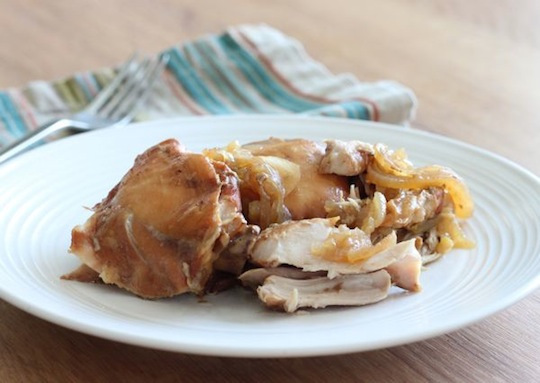 In this Primal version of Filipino chicken adobo adapted for a slow cooker, coconut aminos take the place of soy sauce. The result is a wheat-free, soy free meal that still has the authentic sweet, salty and slightly tart flavor that makes chicken adobo so good.
In this Primal version of Filipino chicken adobo adapted for a slow cooker, coconut aminos take the place of soy sauce. The result is a wheat-free, soy free meal that still has the authentic sweet, salty and slightly tart flavor that makes chicken adobo so good.
While coconut aminos don’t taste exactly like soy sauce, the differences in flavor are harder to detect the longer coconut aminos are cooked. Braising or simmering meat in a sauce laced with coconut aminos adds umami flavor to the dish. The coconut aminos also add a hint of natural sweetness. By the end of the cooking process, the sweet, salty and umami flavors are in perfect balance.
Chicken adobo adds one more flavor element, the subtle zing of vinegar. Way back when, vinegar was used as a marinade to preserve meat before it was cooked. These days, vinegar is added to Filipino adobo as a way to tenderize the meat as it simmers and to enhance the flavor of the dish.
The mouthwatering sauce at the bottom of the slow cooker can be served in a bowl with the chicken or soaked up by cauliflower rice or sautéed greens. The tender meat from chicken adobo is even more flavorful after sitting in the sauce overnight; consider making this recipe specifically to shred the cold chicken over salads for lunch.
Chicken adobo is a classic Filipino dish with innumerable recipes, each one claiming to be the best or most authentic. Using coconut aminos (and a slow cooker) means this recipe isn’t the most authentic, but it’s right up there with the best.
Servings: 4
Time in the Kitchen: 10 minutes of prep, plus 5 hours in the slow cooker
Ingredients:
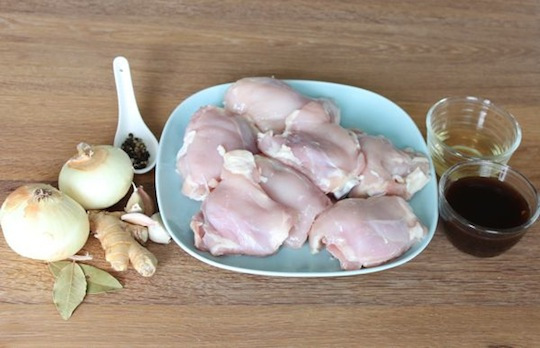
2 yellow onions, sliced
4 garlic cloves, thinly sliced
1 3-inch piece of ginger, peeled and thinly sliced (7.6 cm)
2 1/2 to 3 pounds bone-in skinless chicken thighs (about 8 thighs) (1130 to 1350 g)
2 bay leaves
1 teaspoon peppercorns (5 ml)
1/2 cup coconut aminos (120 ml)
1/4 cup apple cider vinegar (60 ml)
Instructions:
Put the onion, garlic and ginger in the bottom of a slow cooker.
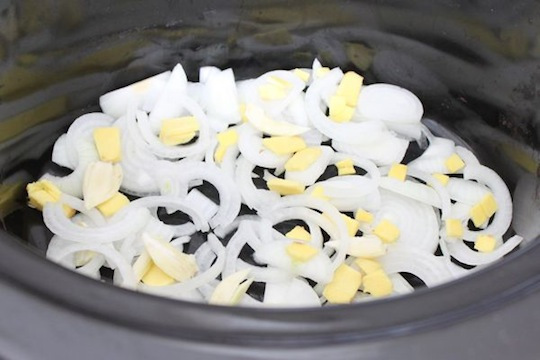
Lay the chicken on top and scatter the bay leaves and peppercorns. Season the chicken lightly with salt.

Pour the coconut aminos and vinegar on top.
Cook 5 hours on low.

Like This Blog Post? Dig Deeper with Primal Blueprint Books and Learn How You Can Reprogram Your Genes to Become Leaner, Stronger and Healthier




Mark Sisson's Blog
- Mark Sisson's profile
- 199 followers



